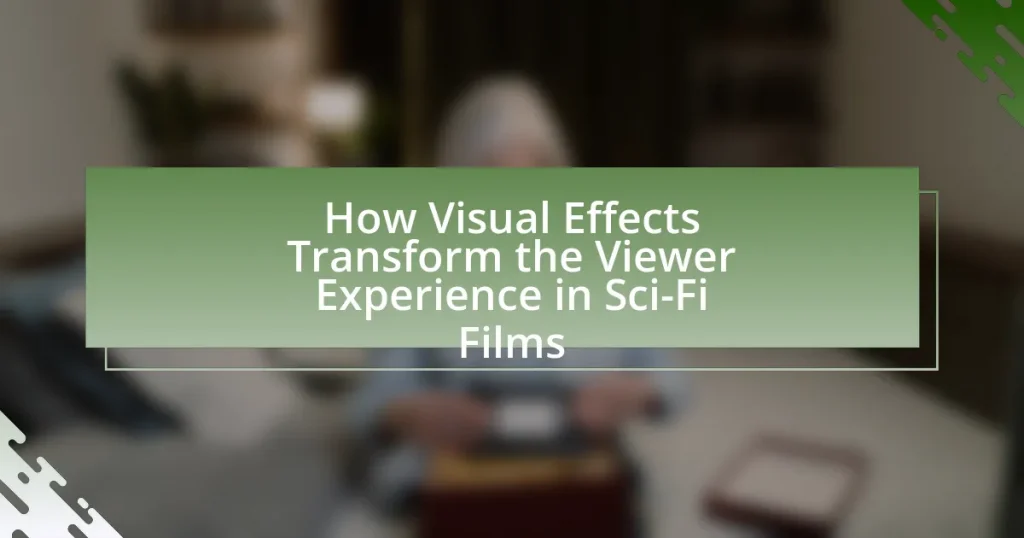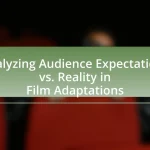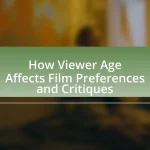The article examines how visual effects transform the viewer experience in sci-fi films, emphasizing their role in creating immersive worlds and enhancing storytelling. It discusses the importance of visual effects in depicting complex narratives, futuristic technologies, and emotional engagement, highlighting techniques such as CGI, motion capture, and practical effects. The article also explores the impact of technological advancements on visual effects, best practices for their integration, and the balance between creativity and technology in filmmaking. Overall, it underscores the significance of visual effects in making sci-fi narratives believable and engaging for audiences.
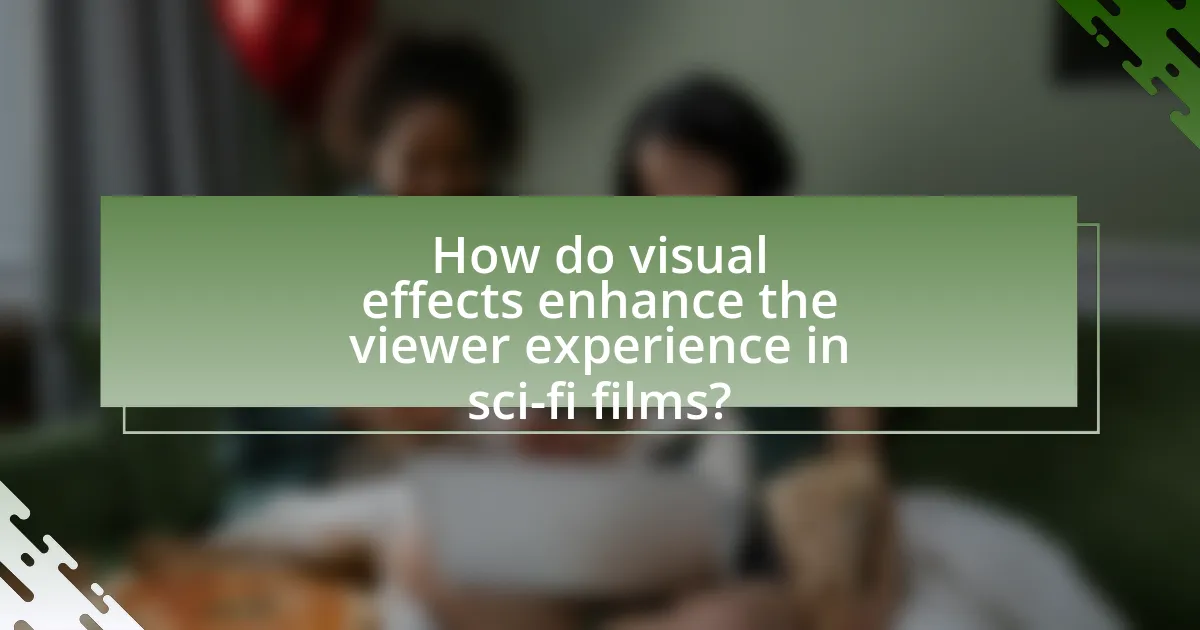
How do visual effects enhance the viewer experience in sci-fi films?
Visual effects enhance the viewer experience in sci-fi films by creating immersive worlds and believable scenarios that captivate audiences. These effects allow filmmakers to visualize complex concepts, such as space travel or alien life, which would be impossible to depict realistically without technology. For instance, films like “Avatar” utilized groundbreaking visual effects to create the lush, alien environment of Pandora, resulting in a more engaging and emotionally resonant experience for viewers. Additionally, a study by the Visual Effects Society found that 80% of audiences felt that visual effects significantly contributed to their enjoyment of sci-fi films, underscoring their importance in enhancing narrative and emotional depth.
What role do visual effects play in storytelling within sci-fi films?
Visual effects are crucial in storytelling within sci-fi films as they create immersive worlds and enhance narrative elements that are often beyond the scope of practical effects. These effects allow filmmakers to visualize complex concepts, such as advanced technology, alien life forms, and futuristic environments, which are essential for conveying the film’s themes and ideas. For instance, in “Blade Runner 2049,” the use of visual effects not only establishes a dystopian atmosphere but also deepens the emotional resonance of the characters’ journeys. This integration of visual effects into the narrative structure supports the audience’s suspension of disbelief, making the fantastical elements feel tangible and relatable.
How do visual effects create immersive worlds for the audience?
Visual effects create immersive worlds for the audience by enhancing the visual storytelling through realistic and imaginative imagery. These effects allow filmmakers to construct environments and scenarios that would be impossible or impractical to achieve through traditional filming methods. For instance, films like “Avatar” utilize advanced CGI and motion capture technology to create detailed alien landscapes and lifelike characters, which engage viewers and transport them into a different reality. The integration of visual effects with sound design and narrative elements further deepens the audience’s emotional connection, making the experience more compelling. Studies have shown that immersive visual effects can significantly increase viewer engagement and emotional response, as evidenced by the success of blockbuster films that rely heavily on these techniques.
What techniques are used to convey complex narratives through visual effects?
Techniques used to convey complex narratives through visual effects include layering, motion graphics, and color grading. Layering allows multiple visual elements to be combined, creating depth and context that enrich the story. Motion graphics enhance storytelling by animating text and images, making abstract concepts more tangible. Color grading sets the emotional tone and atmosphere, guiding viewer perception and engagement with the narrative. These techniques are essential in sci-fi films, where intricate plots often require visual representation to aid comprehension and immersion. For instance, films like “Inception” utilize these methods to depict complex dream sequences, effectively conveying layered narratives through visual storytelling.
Why are visual effects crucial for the believability of sci-fi films?
Visual effects are crucial for the believability of sci-fi films because they create immersive worlds and realistic scenarios that engage viewers’ suspension of disbelief. In science fiction, where narratives often involve advanced technology, alien life, or fantastical environments, visual effects serve to visualize concepts that are beyond everyday experience. For instance, films like “Avatar” and “Interstellar” utilize cutting-edge CGI and practical effects to depict alien landscapes and complex space phenomena, making the extraordinary seem plausible. This integration of visual effects not only enhances storytelling but also reinforces the film’s internal logic, allowing audiences to connect emotionally with the characters and their journeys.
How do visual effects help in depicting futuristic technologies?
Visual effects enhance the depiction of futuristic technologies by creating realistic and immersive representations that engage viewers’ imaginations. These effects allow filmmakers to visualize advanced concepts, such as space travel, artificial intelligence, and advanced robotics, which may not be feasible with practical effects alone. For instance, films like “Blade Runner 2049” utilize CGI to depict a dystopian future with flying cars and holographic advertisements, effectively conveying a sense of advanced technology. The integration of visual effects not only makes these technologies visually believable but also helps to establish the narrative context, allowing audiences to understand and relate to the futuristic elements presented.
What impact do visual effects have on audience suspension of disbelief?
Visual effects significantly enhance audience suspension of disbelief by creating immersive and believable environments that engage viewers emotionally and cognitively. When visual effects are executed effectively, they can convincingly depict fantastical elements, making the narrative more relatable and the experience more engaging. For instance, films like “Avatar” and “Inception” utilize advanced visual effects to construct intricate worlds and scenarios that captivate audiences, allowing them to accept the implausible as plausible. Research indicates that high-quality visual effects can lead to increased emotional involvement and investment in the story, as demonstrated by studies showing that audiences are more likely to connect with characters and plotlines when the visual representation aligns with their expectations of realism.
How do visual effects influence emotional engagement in sci-fi films?
Visual effects significantly enhance emotional engagement in sci-fi films by creating immersive worlds and experiences that resonate with viewers. These effects allow filmmakers to visualize complex concepts, such as alien environments or futuristic technologies, which can evoke awe, fear, or excitement. For instance, films like “Interstellar” and “Avatar” utilize advanced visual effects to depict vast cosmic landscapes and intricate alien ecosystems, drawing audiences into the narrative and eliciting strong emotional responses. Research indicates that high-quality visual effects can increase viewer empathy and connection to characters, as they make fantastical elements more relatable and believable, thereby deepening the overall emotional impact of the story.
What specific visual effects evoke emotional responses from viewers?
Specific visual effects that evoke emotional responses from viewers include color grading, slow motion, and dynamic lighting. Color grading alters the mood of a scene; for instance, warm tones can create feelings of comfort, while cool tones may evoke sadness or tension. Slow motion emphasizes critical moments, allowing viewers to absorb emotional weight, as seen in films like “Inception,” where time manipulation enhances dramatic impact. Dynamic lighting, such as high-contrast shadows, can heighten suspense or fear, effectively engaging viewers’ emotions. Research indicates that these techniques significantly influence audience reactions, as demonstrated in studies on emotional engagement in film.
How do visual effects enhance character development and relationships?
Visual effects enhance character development and relationships by visually representing emotional states and interactions that may be difficult to convey through dialogue alone. For instance, in films like “Avatar,” the use of advanced visual effects allows for the portrayal of intricate emotional connections between characters through their physical expressions and the vibrant, immersive environments they inhabit. This visual storytelling deepens the audience’s understanding of character motivations and relationships, as seen in the emotional weight carried by the visual representation of the Na’vi’s bond with their world. Such effects create a more engaging viewer experience, allowing audiences to connect with characters on a deeper level, ultimately enriching the narrative.
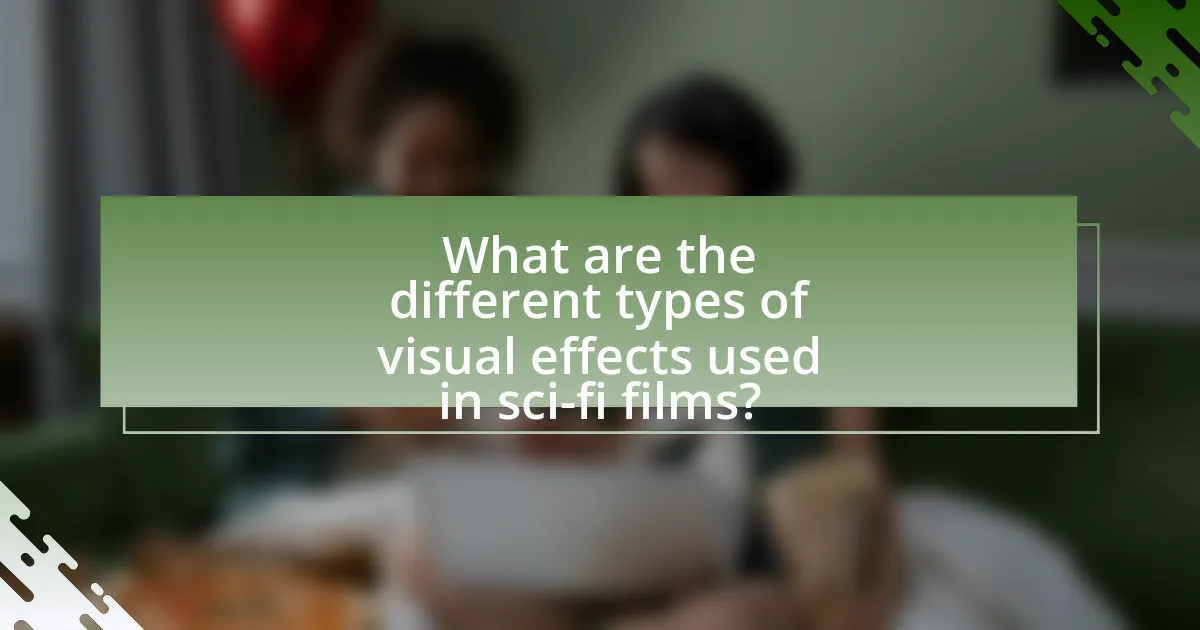
What are the different types of visual effects used in sci-fi films?
The different types of visual effects used in sci-fi films include computer-generated imagery (CGI), practical effects, matte paintings, compositing, and motion capture. CGI is widely utilized to create fantastical elements that cannot be filmed in reality, such as alien worlds or creatures, exemplified by films like “Avatar,” which used advanced CGI to create its immersive environment. Practical effects involve physical props and models, as seen in “Star Wars,” where miniatures were used for space battles. Matte paintings enhance backgrounds and settings, providing depth and detail, while compositing combines various visual elements into a single image, often used in scenes requiring multiple layers of effects. Motion capture technology records actors’ movements to create realistic animations, as demonstrated in “The Lord of the Rings” with the character Gollum. These techniques collectively enhance the viewer’s experience by creating believable and engaging sci-fi narratives.
How do practical effects differ from digital effects in sci-fi films?
Practical effects differ from digital effects in sci-fi films primarily in their method of creation and the tangible presence they provide. Practical effects involve physical props, makeup, and animatronics that are created and filmed in real environments, offering a sense of realism and texture that can enhance viewer immersion. In contrast, digital effects are generated through computer graphics, allowing for greater flexibility and the ability to create complex scenes that may be impossible to achieve practically. For instance, films like “Star Wars” utilized both practical effects, such as miniatures and puppetry, and digital effects, especially in later installments, to create expansive worlds and creatures. This combination allows filmmakers to leverage the strengths of both methods, but the tactile nature of practical effects often resonates more with audiences, as evidenced by the continued popularity of films that prioritize them, such as “Mad Max: Fury Road,” which used extensive practical effects alongside digital enhancements.
What are the advantages of using practical effects in certain scenarios?
Practical effects provide tangible realism and enhance viewer immersion in certain scenarios. Unlike digital effects, practical effects create physical elements that actors can interact with, resulting in more authentic performances. For instance, films like “Star Wars” and “Jurassic Park” utilized practical effects to create lifelike creatures and environments, which contributed to their lasting impact and audience engagement. Additionally, practical effects often require less post-production work, allowing for a more efficient filming process. This efficiency can lead to cost savings and a quicker turnaround for filmmakers, as seen in productions that prioritize on-set effects over extensive CGI.
How has the evolution of digital effects changed the landscape of sci-fi filmmaking?
The evolution of digital effects has fundamentally transformed the landscape of sci-fi filmmaking by enabling unprecedented visual storytelling capabilities. Digital effects allow filmmakers to create complex and imaginative worlds that were previously impossible to realize with practical effects alone. For instance, the introduction of CGI in films like “Jurassic Park” in 1993 showcased the potential of digital effects to bring dinosaurs to life, setting a new standard for realism in visual effects. This shift has led to a significant increase in audience expectations for visual fidelity and creativity in sci-fi narratives, as seen in later films such as “Avatar” and “Interstellar,” which utilized advanced digital techniques to enhance their storytelling. Consequently, the reliance on digital effects has not only expanded the creative possibilities for filmmakers but has also redefined the viewer experience, making it more immersive and engaging.
What are some notable examples of visual effects techniques in popular sci-fi films?
Notable examples of visual effects techniques in popular sci-fi films include CGI (computer-generated imagery), practical effects, and motion capture. CGI has been prominently used in films like “Avatar,” where it created immersive alien worlds and characters, contributing to its box office success of over $2.8 billion. Practical effects were effectively utilized in “Star Wars,” particularly in the original trilogy, where models and animatronics brought a tangible quality to space battles and creatures. Motion capture technology, exemplified in “The Lord of the Rings” with the character Gollum, allowed for realistic character animation, enhancing emotional engagement and earning the film multiple Academy Awards. These techniques collectively transform the viewer experience by creating believable and visually stunning narratives.
How did groundbreaking films set new standards for visual effects?
Groundbreaking films set new standards for visual effects by pioneering innovative techniques and technologies that enhanced realism and immersion. For instance, “Star Wars” (1977) introduced motion control photography, allowing for complex space battles and dynamic camera movements, which revolutionized how visual effects were created. Similarly, “Jurassic Park” (1993) utilized groundbreaking CGI to bring dinosaurs to life, demonstrating the potential of computer-generated imagery in creating lifelike creatures. These advancements not only elevated the visual storytelling in films but also established benchmarks for future productions, influencing industry standards and audience expectations for visual effects.
What lessons can be learned from the visual effects of iconic sci-fi films?
The visual effects of iconic sci-fi films teach the importance of innovation, storytelling, and audience immersion. These films, such as “Star Wars” and “Blade Runner,” demonstrate how groundbreaking visual effects can enhance narrative depth and create believable worlds. For instance, “Star Wars” utilized practical effects and pioneering CGI to establish a new standard in filmmaking, influencing countless subsequent productions. Additionally, the visual effects in “Avatar” showcased the potential of 3D technology to engage viewers on a deeper emotional level, proving that effective visual storytelling can significantly elevate the viewer experience.

How do advancements in technology impact visual effects in sci-fi films?
Advancements in technology significantly enhance visual effects in sci-fi films by enabling more realistic and immersive experiences. Technologies such as CGI (computer-generated imagery), motion capture, and real-time rendering allow filmmakers to create intricate and lifelike environments, characters, and special effects that were previously unattainable. For instance, the use of CGI in films like “Avatar” (2009) revolutionized the portrayal of alien worlds and creatures, showcasing the capabilities of advanced visual effects technology. Additionally, motion capture technology, as seen in “The Lord of the Rings” (2001-2003), allows for the realistic animation of characters, blending human performances with digital enhancements. These technological advancements not only improve the visual quality but also deepen audience engagement, making the sci-fi genre more compelling and believable.
What technological innovations have revolutionized visual effects in recent years?
Recent technological innovations that have revolutionized visual effects include real-time rendering, virtual reality (VR), and artificial intelligence (AI) integration. Real-time rendering, exemplified by engines like Unreal Engine, allows filmmakers to visualize complex scenes instantly, enhancing creativity and efficiency. Virtual reality has enabled immersive experiences, allowing audiences to engage with sci-fi narratives in unprecedented ways. AI integration, particularly in image processing and animation, streamlines workflows and enhances realism, as seen in projects like “The Mandalorian,” which utilized AI for background generation. These advancements collectively transform viewer experiences by creating more engaging and lifelike visual narratives in sci-fi films.
How do software advancements improve the quality of visual effects?
Software advancements significantly enhance the quality of visual effects by enabling more realistic rendering, improved simulation of physical phenomena, and streamlined workflows. For instance, advancements in ray tracing technology allow for accurate light behavior, resulting in lifelike shadows and reflections that elevate the visual experience. Additionally, software like Autodesk Maya and Adobe After Effects incorporates machine learning algorithms to automate complex tasks, reducing production time while maintaining high fidelity. These improvements are evidenced by the increasing use of high-resolution textures and detailed 3D models in contemporary films, which contribute to a more immersive viewer experience in sci-fi genres.
What role does artificial intelligence play in the creation of visual effects?
Artificial intelligence significantly enhances the creation of visual effects by automating complex processes and improving efficiency. AI algorithms can analyze vast amounts of data to generate realistic simulations, such as fluid dynamics or particle effects, which traditionally require extensive manual labor. For instance, AI-driven tools like deep learning models can create lifelike animations and textures, reducing the time and cost associated with visual effects production. Additionally, AI assists in tasks like rotoscoping and compositing, where it can identify and isolate elements in footage with high precision, streamlining workflows. This integration of AI not only accelerates production timelines but also elevates the quality of visual effects, making them more immersive and engaging for viewers in sci-fi films.
How do filmmakers adapt to new visual effects technologies?
Filmmakers adapt to new visual effects technologies by integrating advanced tools and techniques into their production processes. This adaptation often involves training crews on the latest software, collaborating with visual effects artists, and incorporating real-time rendering technologies to enhance storytelling. For instance, the use of virtual reality and augmented reality in films like “The Mandalorian” demonstrates how filmmakers leverage new technologies to create immersive environments, allowing for greater creative freedom and efficiency in production. Additionally, the adoption of motion capture technology has revolutionized character animation, as seen in films such as “Avatar,” where filmmakers utilized cutting-edge visual effects to bring lifelike characters to the screen.
What challenges do filmmakers face when integrating new technologies into their work?
Filmmakers face several challenges when integrating new technologies into their work, including high costs, the need for specialized skills, and potential disruptions to traditional workflows. The financial investment required for cutting-edge technology can be substantial; for instance, the budget for visual effects in major films often exceeds millions of dollars, which can strain production finances. Additionally, filmmakers must acquire or develop expertise in new tools and software, as the rapid evolution of technology demands continuous learning and adaptation. This necessity can lead to delays in production schedules, as teams may need time to familiarize themselves with unfamiliar systems. Furthermore, integrating new technologies can disrupt established creative processes, requiring filmmakers to rethink storytelling techniques and visual aesthetics, which can create tension between innovation and traditional filmmaking practices.
How can filmmakers balance creativity with technological capabilities?
Filmmakers can balance creativity with technological capabilities by integrating innovative storytelling techniques with advanced visual effects. This integration allows filmmakers to push the boundaries of imagination while utilizing the latest technology to enhance the viewer’s experience. For instance, films like “Avatar” and “Inception” showcase how creative narratives are complemented by cutting-edge CGI and practical effects, resulting in immersive worlds that captivate audiences. The successful use of technology in these films demonstrates that when filmmakers harness technological advancements thoughtfully, they can elevate their creative vision and produce compelling cinematic experiences.
What are best practices for utilizing visual effects in sci-fi films?
Best practices for utilizing visual effects in sci-fi films include integrating effects seamlessly with live-action footage, prioritizing storytelling over spectacle, and using practical effects alongside digital enhancements. Seamless integration ensures that visual effects enhance the narrative without drawing attention to themselves, as demonstrated in films like “Blade Runner 2049,” where visual effects complement the story’s atmosphere. Prioritizing storytelling ensures that effects serve the plot, as seen in “Interstellar,” where visual representations of black holes enhance the emotional depth of the narrative. Additionally, combining practical effects with digital enhancements, as utilized in “Star Wars,” creates a tangible realism that resonates with viewers, making the sci-fi world more immersive.
How can filmmakers ensure visual effects serve the story rather than overshadow it?
Filmmakers can ensure visual effects serve the story by integrating them seamlessly into the narrative and character development. This approach involves using visual effects to enhance emotional moments, support plot progression, and maintain the audience’s focus on the story rather than the technology. For instance, in “Avatar,” director James Cameron utilized groundbreaking visual effects to create an immersive world that complemented the themes of environmentalism and connection, rather than distracting from them. By prioritizing storytelling over spectacle, filmmakers can create a cohesive experience where visual effects enhance rather than overshadow the narrative.
What tips can be applied to effectively blend practical and digital effects?
To effectively blend practical and digital effects, filmmakers should prioritize seamless integration by ensuring consistent lighting and color grading across both elements. This approach enhances realism, as mismatched lighting can break the illusion. Additionally, using practical effects as a foundation allows digital artists to build upon tangible elements, creating a more cohesive final product. For instance, films like “Jurassic Park” utilized animatronics alongside CGI, resulting in a believable interaction between characters and creatures. This method demonstrates that combining the tactile nature of practical effects with the versatility of digital effects can significantly enhance viewer immersion in sci-fi narratives.
